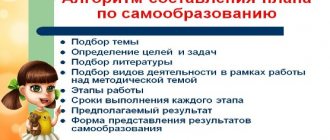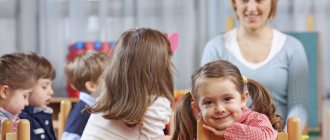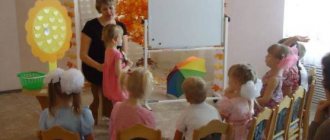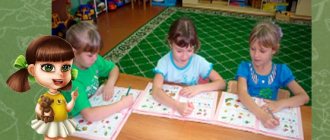Teacher self-education plan on the topic “Health-saving technologies in preschool educational institutions”
Purpose of the work: to improve one’s professional skills and competence in the use of health-saving technologies in the educational process of children of senior preschool age.
Tasks:
- protect and strengthen the health of children, improve their physical development, enhance the body’s properties, improve physical and mental performance through the introduction of health-saving technologies;
- expand and strengthen children’s understanding of the health benefits of vegetables, harvesting and using various parts of garden plants for food;
- to form ideas about the importance of sanitary and hygienic procedures for human health;
- to form preschoolers’ ideas about human health and illness; reveal the cause of some diseases caused by non-compliance with sanitary and hygienic rules;
- to form children’s ideas about the possibility of improving health through physical exercise, to introduce children to sports;
- to form in children ideas about the features of life in a big city; about environmental factors that have a special impact on human health;
- to form in preschoolers a conscious attitude towards health as a leading value and motivation for a healthy lifestyle, accumulation of knowledge about health;
- Develop a long-term plan for working with children and parents;
- prepare (conduct) consultations for parents and teachers on the topic of self-education;
- interact with parents on the use of health-saving technologies in preschool educational institutions and families, unite the efforts of employees and parents for effective health-improving work.
Stage of work on the topic of self-education: 1 year.
Relevance
The norm of life and behavior of every person should be a conscious and responsible attitude towards health as a social value. It is indisputable that the level and duration of a person’s life, as well as the state of his health, is largely determined by the model of behavior formed in childhood. And one of the sides of this process should be the formation of a culture of health, as part of a person’s general culture - awareness of health as a vital value, fostering a responsible attitude towards one’s health, the health of others and the natural environment.
Preschool age is decisive in forming the foundation for the physical and psychological health of children. It is during this period that intensive development of organs and the formation of functional systems of the body takes place, the main personality traits are laid, character and attitude towards oneself and others are formed. During this period, the child develops basic skills for developing a healthy lifestyle culture; this is the most favorable time for developing the right habits, which, in combination with teaching preschoolers how to improve and maintain health, will lead to positive results.
The problem of nurturing the personal interest of each person in a healthy lifestyle (HLS) has been especially relevant in recent years due to the negative trend towards deterioration in the health of all socio-demographic groups of the Russian population and especially preschool children.
Every year the percentage of children with health problems increases, and there is a tendency for a continuous increase in the overall level of disease among preschoolers. This is due to a lot of negative phenomena of modern life: severe social upheavals, environmental problems, low level of development of the institution of marriage and family; massive spread of alcoholism, smoking, drug addiction; weak health care system and educational base of educational institutions and families.
The well-being of society as a whole depends on the level of mental and physical condition of the population, on the state of its health, therefore the problem of forming children’s ideas about a healthy lifestyle for children seems relevant in modern society.
This problem is especially significant in the preschool period of childhood - the most favorable for the active development of cognitive processes and the child’s personality, his ideas about a healthy lifestyle.
Forms of working with children:
- joint activities of the teacher and children;
- individual work with children;
- free independent activity of children.
Forms of work with parents:
- consultations;
- individual and group conversations;
- design of visual information (stands, sliding folders);
- involvement in enriching the developmental subject-development environment of the group.
Technologies used: health-saving, gaming, information and communication, personality-oriented.
Expected results:
- mastering healthy lifestyle skills for children;
- reducing the number of diseases most common in preschool institutions;
- improvement of the physical education system based on the implementation of an individual approach;
- increasing the interest of kindergarten workers and parents in promoting the health of preschool children;
- stimulating increased attention of preschoolers and their parents to issues of health, nutrition, healthy lifestyle, rational physical activity;
- RPPS group has been replenished.
Products of pedagogical activity within the framework of self-education on the topic:
- Booklets, memos, brochures, consultations and recommendations for parents.
- Replenishment of the methodological piggy bank.
- Presentation by a teacher on the topic of self-education.
Annex 1
Teacher self-development plan
Preparatory stage
| The content of the work | Target |
| Studying methodological literature, periodicals, scientific literature, educational literature. | In-depth study of methods and forms of working with children on the topic of self-education. |
| Selection of specific techniques, methods and types of work for self-education. | Determine the goals and objectives of practical activities; means and methods for professional self-development. |
| Study of normative documents, periodicals. | Familiarization with new documentation on conducting teaching activities in a preschool institution. |
| Improving your PC experience. Use of educational Internet resources. | Mastering various teaching methods and techniques; using them in your activities. |
| Participation in professional competitions. | Development of creative potential in professional activities. |
| Study and analysis of psychological and pedagogical literature. Analysis and assessment of your activities and the activities of children. | Development of personal qualities that contribute to high results and elimination of shortcomings. |
| Mastering innovative forms of working with families. Study of families and parents' pedagogical capabilities. Familiarization with the experience of colleagues. | Master the forms of working with parents. |
| Message for parents on the topic “Components of a healthy lifestyle” | Attract the attention of parents to the topic of self-education |
Main stage
| Month | Work with children | Working with teachers | Working with parents | Developmental environment |
| September | Lesson “How does the human body work?” Goal: to introduce children to the external structure and capabilities of the human body (a person can look, hear, breathe, think, run...) Conversation “How does a person grow?” D\I “I can - I can’t” | “Creating a health-saving space” - practical recommendations for educators in educational institutions. | Methodological recommendations “Organization of hardening procedures at home” Questionnaire “Culture of health in kindergarten” | Creating an algorithm with children. “Rules in pictures - correct posture” Create a stand from children's works. |
| October | Presentation “Skin is a Helper” Purpose: to form children’s understanding of the protective function of human skin; strengthen hygienic skin care skills. Reading literature: N. Knushevitskaya “Skin”; G. Yudin “Microbes” Conversation “First aid for cuts, bruises and scratches” Purpose: to teach children to react correctly to minor injuries and the ability to provide first aid. | Methodological recommendations: “Game is a means of protecting a child’s health.” | Consultations: “Healthy children - in a healthy family” “ARVI and influenza” Exhibition of drawings by children and parents “Our healthy and athletic family”. | D\I "Labyrinths of Health". Objectives: consolidate knowledge about personal hygiene items and their purpose. Teach children to see the boundaries of the picture (in this case, paths, draw lines without lifting your finger from the picture; develop thinking, logic, eye, perseverance, will; teach them to embrace the whole picture as a whole, mentally build a “travel” route. Material: cards with images of labyrinths. Description: the child is given the task of finding the way from a personal hygiene item to the part of the body for which it is intended.Explain how and why this item is used. |
| November | Game “Breathe - Don’t Breathe” Goal: to provide knowledge about the structure of the respiratory organs, the importance of clean air for human health. Experimentation. Experiment “Is there a lot of air in the lungs?” Purpose: to show the need for exercises that increase lung capacity. Reading x/l “How to become a Neboleyka” by N. Semenov | Consultation “Modern technologies for preserving and promoting health” | Sports festival “Dad, Mom and I – a sports family” Involve parents in raising a healthy child, help improve the microclimate in the family. | Making “Acupressure massage” patterns with children. |
| December | Conversation “Microbes and Viruses” Purpose: to give children a basic understanding of infectious diseases and their causative agents. C\P game “Hospital (laboratory)” Purpose: To introduce children to the profession of a laboratory assistant, to consolidate knowledge about pathogens and ways to combat them. Experimentation. Experiment “Is it possible to eat snow and icicles?” Goal: to show children through experience that snow turns into dirty water - a source of disease, to teach them to draw conclusions. | Practical recommendations on the topic: “Game acupressure for the prevention and treatment of a runny nose” | Consultations: “Walking and its importance for a child’s health” Conversation “Weekend in the fresh air with a child” | “Creating your own laboratory in a group” - selecting play equipment, making game attributes together with the children. |
| January | Conversation “What happens when we eat?” Goal: to familiarize children with the importance and functioning of the body’s digestive system. Reading x/l N. Knushevitskaya “Teeth”, “Stomach”; R. Corman and L. Lieberman “This Junk Food.” D\I “Healthy and unhealthy food” | Methodological recommendations: “Organization of interaction with the family to form the foundations of a healthy lifestyle in preschool children” | Consultations: “Is it tasty and healthy?” “If your child is allergic” Folder – moving “Winter games and entertainment” | D\I “Harmful - Beneficial” Objectives: to form ideas about preventive measures and health protection. Develop visual perception, voluntary attention, logical thinking, grammatically correct speech. Material: paired cards with chips that are opposite in meaning to health - pictures depicting actions that are harmful or beneficial in a given situation Description: 1. The child is asked to look at the pictures and determine which of them depict actions that are harmful to human health, and which ones are, on the contrary, useful. Option 2. The child is offered cards that are opposite in meaning to health. He needs to fill the empty windows on them with chips - pictures that correspond to the conditions of a given situation. |
| February | Conversation “Day routine” Goal: to form children’s ideas about the correct daily routine and the health benefits of following it. C\R game "Kindergarten" (regime moments) Purpose: to show in the game how the daily routine is observed in the kindergarten, to emphasize its importance. Reading x/l O. Ivanenko “Good night” Purpose: to clarify the importance of sleep for human health” | Report on the topic: “Health-saving technologies in preschool educational institutions” | Consultations “Therapeutic gymnastics” “Stop the flu” Organization of a photo exhibition “Movement is Life” Conversation “TV, computer and health!” | D\I “What first - what then (daily routine) Objectives: to reinforce the idea that following the correct daily regimen is good for health. Develop the ability to coherently and consistently explain your actions. Material: plot pictures depicting actions characteristic of a certain period of the day. Description: invite the child to arrange the pictures in the correct sequence, explaining his choice. |
| March | Conversation “If you want to be, toughen up!” Goal: To consolidate children's knowledge about the role of hardening in promoting human health. Reading x/l S. Mikhalkov “Mimosa” Purpose: to give an idea of hardening and the prevention of colds. D\I “Dress correctly” Goal: Continue familiarization with the properties of clothing in different seasons. | Consultation “Components of a healthy lifestyle” | Consultations: “The influence of natural factors on hardening.” Competition for parents: “Project to equip an area for physical activity of children” | Modeling “Athletes” - teach how to depict a human figure in motion, correctly observing proportions. |
| April | Conversation “Posture - slender back” Purpose: to introduce children to the rules of maintaining correct posture. | Consultation: “Child’s health and the foundation of the culture of a future adult.” | Consultations: “Cultural and hygienic education in the family” “Posture and its importance for improving the health of children.” | Creation of a photo album of family posters: “My family and sports” |
| May | Final OOD “Let’s help Pinocchio become healthy” Exhibition of children’s drawings “How we improve health!” Conversation “Rules of behavior on the water” Goal: To develop children’s skills for safe behavior on the water. | Experience in creating “Family Traditions for Healthy Lifestyle” with parents. | Consultations: “Healthy lifestyle in the family” “Beware of ticks! Consultations: “Summer holidays”. | Equipping a group site for the development of children’s motor activity in the summer. |
| During a year | Involving parents of students in making games and materials to enrich the health center with their own hands. | |||
| May | Open Day. Presentation of the Health Center | |||
| Presentation of a work report on the topic of self-education | ||||
Literature:
1. Shukshina S.E. Me and my body: a guide for teaching children with practical tasks and games. – M.: School Press, 2004;
2. Kuznetsova M. N. System of comprehensive measures for the improvement of children’s health in preschool educational institutions. M.:ARKTI, 2002;
3. Lazareva N. N. An integrated approach to organizing a healthy lifestyle for a child: Methodological recommendations for employees of preschool educational institutions // N. N. Lazareva, A. A. Astashkina. Togliatti, 2004;
4. Yakovleva T. S. “Health-saving technologies of education in kindergarten” - M.: School Press, 2006;
5. Pavlova M.A., Lysogorskaya M.V. “Health-saving system of a preschool educational institution” - Volgograd, Uchitel Publishing House, 2012;
6. Bryazgunov I.P. “Teach children not to get sick” - Moscow, Humanitarian Publishing House, 2004;
7. Novikova I.M. “Formation of ideas about a healthy lifestyle among preschool children” - M.: Mozaika-Sintez, 2010;
8. Scientific and practical journal “Health Worker” of Preschool Educational Institution No. 3, 2009;
9. Internet resources, access point: www.refoteka.ru.
Topic: “Use of health-saving technologies with children of primary preschool age”
Transcript
1 Municipal budgetary preschool educational institution kindergarten "Little Red Riding Hood" Self-education work plan for the school year for the teacher of the secondary group "Vaselek" Topic "Use of health-saving technologies with children of primary preschool age" Kirillova O. P.
2 Relevance Preschool age is a decisive stage in the formation of the foundation of a child’s physical and mental health. During this period, there is intensive development of organs and the formation of functional systems of the body. Technologies, as an effective system of measures for preventive work with children, aimed at preserving and strengthening the health of pupils, are called “health-saving technologies”. Health is a state of complete physical and social well-being of a person and not merely the absence of disease or infirmity. The topic of my self-education is directly related to the solution of this problem - “The use of health-saving technologies in working with preschool children.” Goal: “To increase the professional level of knowledge on the issue of modern health-saving technologies used in working with preschool children.” Objectives: 1. Study educational, reference, scientific and methodological literature on the issue of health conservation. 2. Learn to model work based on the studied types, techniques and methods of health preservation (various types of play massage, self-massage, sets of general developmental exercises, physical education, outdoor games, etc.). 3. Create conditions for preserving and strengthening children’s health, based on the integrated and systematic use of health-saving technologies available to kindergartens. 4. To form in children the foundations of a healthy lifestyle and to ensure that basic rules of health conservation are followed. 5. Increase the pedagogical knowledge of parents in matters of children's health; formation of responsibility for the health of their children, motivation for a healthy lifestyle. 2
3 Self-realization 1. Selection of literature on the topic - September-October 2. Study of literature on this topic. - September-May 3. Development of a long-term plan for working with children in the middle group on health conservation - September 4. Development of a summary of the OOD on the formation of the foundations of a healthy lifestyle "Microbes". - October, OOD on the formation of the foundations of a healthy lifestyle "Magic Vitamins" - December, OOD on the formation basics of healthy lifestyle “My body” - February. 5. Making card files: “Gymnastics for the eyes”, “Breathing gymnastics”, “Outdoor games”, “Physical education”, “Finger games”. - September-May (daily) 6. Preparation of memos, booklets and consultations for parents on this topic - September - May 7. Development of sports entertainment: “A healthy mind in a healthy body” - May Expected results: - creation of an educational environment that shapes children's ideas about the basics of a healthy lifestyle and the active inclusion of pupils in this environment; — reduction in morbidity rates; — positive dynamics of indicators of children’s physical development. 3
4 Long-term plan Month Form of implementation Objectives Work with parents September October November Diagnosis of the level of physical development of children. Monitoring children's behavior and health status in everyday life. OOD on the formation of the foundations of a healthy lifestyle “Microbes”. Watch the video: “Microbes around us.” “Self-massage” Conversation with children “What is massage”, Viewing the presentation: “Magic massage”. "Breathing exercises". Identification of frequently ill children, identification of physical fitness and motor skills. Give children a basic understanding of germs and ways to protect themselves from them. Teach children to take responsibility for their dental health; consolidate the rules and skills of dental care. Introduce children to infectious diseases and their causative agents (microbes, viruses). Continue to expand knowledge about personal care products. To instill in children the right attitude towards Teaching children self-massage techniques. Prevent colds by affecting active points. Cultivate an interest in healing massage. Cultivate a caring attitude towards your body. Formation of the breathing apparatus. Consultation for parents “Health-saving technologies in preschool educational institutions.” Design of a travel folder: “Types of health-saving technologies” “How to tell a child about germs?” Invite parents to read O. Epifanova’s “Children about hygiene” at home with their children. In pursuit of harmful microbes." “Self-massage is another step towards improving health.” 4
5 December January February OOD on the formation of the foundations of a healthy lifestyle “Magic Vitamins”. View the presentation: “Vitamins in a basket.” "Physical training minutes." Looking at pictures, photos, winter sports. Conversation with children “Types of sports”. Watch the video “Winter Sports”. "Finger games" Looking at pictures “My body”. OOD for the formation of the foundations of a healthy lifestyle “My Body”. “Active games” To form children’s ideas about proper nutrition and a healthy lifestyle. Introduce the concept of “vitamins” and their role in human life. Reinforce the concepts of “vegetables,” “fruits,” “berries,” and the benefits of consuming them. Foster a desire for a healthy lifestyle. Aimed at restoring the performance of children, improving them Expanding children's ideas about the surrounding reality through introducing children to winter sports. Clarify children's knowledge about winter sports. To promote the development of the ability to distinguish the simplest relationships between a sport and its attributes. Ensure that the vocabulary on the topic is enriched and clarified. To promote the development of logical To form in children elementary ideas about the human body. Enrich children's vocabulary with folk proverbs and sayings about health. Continue to instill culturally hygienic skills. Help children remember the rules of caring for their body. Learn to apply acquired knowledge in practice. To develop children's powers of observation, “Vitamins in a basket.” “Sport is life”, “How to keep your child busy on weekends”. Folder moving “Taking care of the child’s health” 5
6 March April May Conversation with children “I am growing healthy!”, Presentation “I am growing healthy!”. "Gymnastics for the eyes." Conversation with children “Why do we harden ourselves?” View the presentation “A healthy body, a healthy mind.” Articulation gymnastics. Joint physical education activity with parents “A healthy mind in a healthy body!” Expanding ideas about health and important components of a healthy lifestyle (proper nutrition, movement, sleep) and factors that destroy health, fostering the desire to lead a healthy lifestyle. Fatigue prevention. Strengthening the eye muscles. Relieving tension. Continue to teach children to take care of their health. Strengthen the idea of the value of health: create a desire to lead a healthy lifestyle. Improve the idea that morning exercises, games, and physical exercises cause a good mood; With the help of sleep, strength is restored. Cultivate neatness, the ability to notice disorder in clothing. Exercise Increase children's interest in physical education, cultivate friendly relationships, the desire for a healthy lifestyle, develop dexterity, and coordination of movements. Involve parents in joint activities with children. Consultation for parents “Let's take care of children's vision. Gymnastics for the eyes" Consultation for parents "Toughening up children at home." “Articulation gymnastics with a child at home is fun, useful and interesting.” Encourage parents to share discernment with their children. References: Arsenevskaya. O. N., System of musical and recreational work in kindergarten., Publishing house "Teacher" 2009 Voloshina L. Organization of health-saving space // Preschool education N1.-S Vorotilkina I. M. Physical education and recreational work in a preschool educational institution. -M. : Enas, p. Gorbatenko O. F., T. A. Kadrailskaya, G. P. Popova, Physical education and health work, Publishing House "Teacher" 2007. Karepova T. G., Formation of a healthy lifestyle among preschool children, Uchitel Publishing House, 2009 6
7 Konina E. Yu. Formation of cultural and hygienic skills in children. Game set. - Iris Press, p. Nikolaeva E.I. et al. Health conservation and health formation in a kindergarten. M. St. Petersburg: Detstvo-Press, Novikova I. M. Formation of ideas about a healthy lifestyle in preschool children. A manual for teachers of preschool institutions. M.: MOSAIC - SYNTHESIS, Savelyeva N. Yu. Organization of health work in preschool educational institutions. Rostov-on-Don Soldatchenko S.S., Kashchenko G.F. et al. Aromatherapy. Prevention and treatment of diseases with essential oils. “Tavrida”, Simferopol, 1999 Simkina, P. L. The ABC of Health: Health-preserving physical education minutes / P. L. Simkina, L. V. Titarovsky. M.: Amrita-Rus, 2006 Ternovskaya S. A., Teplyakova L. A. Creating a health-saving educational environment in a preschool educational institution // Methodist N4.-S



